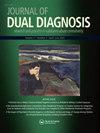Journal of Dual Diagnosis: Highlights From 2022.
IF 1.5
4区 医学
Q3 PSYCHIATRY
Journal of Dual Diagnosis
Pub Date : 2023-01-01
Epub Date: 2023-01-02
DOI:10.1080/15504263.2023.2160141
引用次数: 0
双重诊断杂志:2022年的亮点。
本文章由计算机程序翻译,如有差异,请以英文原文为准。
求助全文
约1分钟内获得全文
求助全文
来源期刊

Journal of Dual Diagnosis
Multiple-
CiteScore
4.90
自引率
13.60%
发文量
20
期刊介绍:
Journal of Dual Diagnosis is a quarterly, international publication that focuses on the full spectrum of complexities regarding dual diagnosis. The co-occurrence of mental health and substance use disorders, or “dual diagnosis,” is one of the quintessential issues in behavioral health. Why do such high rates of co-occurrence exist? What does it tell us about risk profiles? How do these linked disorders affect people, their families, and the communities in which they live? What are the natural paths to recovery? What specific treatments are most helpful and how can new ones be developed? How can we enhance the implementation of evidence-based practices at clinical, administrative, and policy levels? How can we help clients to learn active recovery skills and adopt needed supports, clinicians to master new interventions, programs to implement effective services, and communities to foster healthy adjustment? The Journal addresses each of these perplexing challenges.
 求助内容:
求助内容: 应助结果提醒方式:
应助结果提醒方式:


